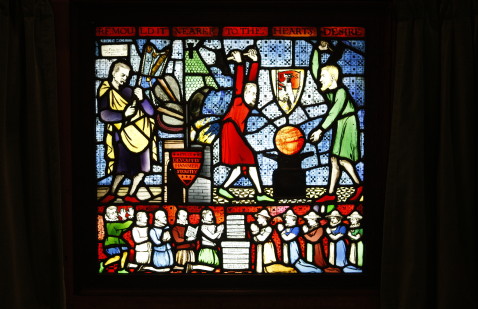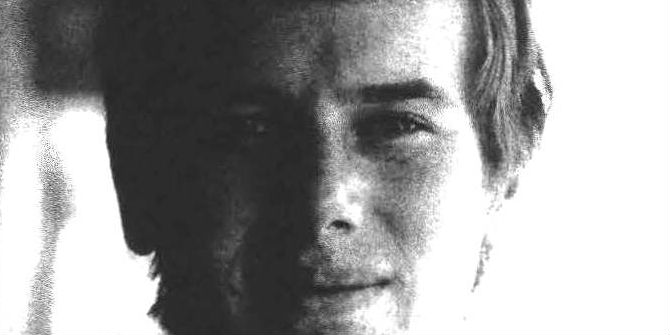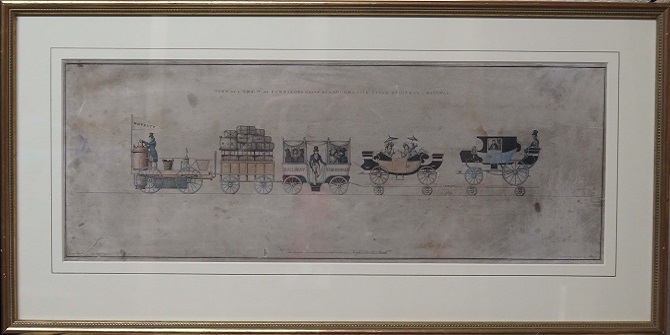In an episode of Great British Railway Journeys, released in 2019, Michael Portillo visited LSE. He accompanied archivist Sue Donnelly to the Shaw Library to learn about the four founders of the School, their Victorian social reformer ideals, and why they decided to create a university like LSE.
In the programme Great British Railway Journeys, former politician Michael Portillo uses Bradshaw’s, a 19th century guide to the railways, to navigate his way by train across Great Britain. The episode in which he visits LSE is from series 10. It covers a tube journey into Victorian and Edwardian London, from Ealing Broadway to South Kensington – via Houghton Street.
Alighting first at Ealing Broadway, Michael Portillo visits Ealing Studios, built in 1902 and home to British films like Passport to Pimlico and classic series like Monty Python. He meets make up artist Sian who transforms him into a solider as students look on. Later and back in his own attire, Michael notes that the Victorian era didn’t only see the emergence of the tube network, as Joseph Bazalgette’s sewer network is another feature of London’s subterranean world. He stops off at Putney Bridge meet Lucy, who shows him work on London’s latest tunnel, in Fulham.
His next stop is the familiar site of the Old Building at LSE. Here Michael Portillo meets archivist Sue Donnelly. Up in the Shaw Library, which opened in 1928 as a common room for students, he asks about LSE’s first prospectus, and the gap the founders of LSE felt needed to be filled. Sue explains:
[LSE’s founders] really felt there was a lack in systemic training for people who wanted to work in government or local government or welfare or business. And secondly, they were also very aware that there was no real original research being systematically done into contemporary society.
Michael informs viewers that LSE was established in 1895 by four members of the socialist Fabian Society, an organisation committed to creating a democratic society along socialist lines: husband and wife Sidney Webb and Beatrice Webb, political scientist Graham Wallas and dramatist George Bernard Shaw.
Sue guides Michael to the Fabian window, a stained glass window in the Shaw Library, which was commissioned around 1910, probably by George Bernard Shaw and his wife Charlotte Shaw, as a caricature of the Fabian Society members at the time. On the Fabian window, Sidney Webb and George Bernard Webb are shown hammering out a new world on the anvil. Above them is the “wolf in sheep’s clothing” emblem of the Fabian Society. Michael reads the text on the window: “Remould it nearer to the heart’s desire. Pray devoutly, hammer stoutly”. He notes with a laugh, “they were quite modest about their aims, weren’t they!”

“One of the key areas of the Fabian Society was doing research,“ continues Sue, “and publishing resources for people who were campaigning.” Of the list of titles depicted on the window, Industrial Democracy, History of Trade Unionism and English Local Government were written by Beatrice and Sidney Webb. When Michael questions whether a history could be influential, Sue replies:
One of the things that Sidney and Beatrice Webb were saying when they published things like History of Trade Unionism is that these subjects are important and they need to be looked at, and they need to be considered; they have an impact on people’s lives. And previously it had perhaps been thought that things like that were not worthy of being investigated by serious academic researchers.
Michael then heads to the New Academic Building (now known as the Cheng Kin Ku Building) to find out whether these founding ideals strike a chord with students today. The students understood the founding ideals and when Michael asked whether Fabian values were still prominent, there was discussion around the diverse political leanings of LSE students today.
After leaving LSE, Michael heads to South Kensington to learn about the Budokwai martial arts club, the oldest such club in Europe, opening in 1918. Instructor Peter, who believes the underlying chivalrous Samurai code would have appealed to the Edwardians, gives Michael his first judo lesson.
Michael Portillo concludes his visit to London, but not before telling viewers that ideas from the London School of Economics inspired the National Health Service, and the welfare state after the Second World War.
Watch Great British Railway Journeys on BBC iPlayer or UKTV Play






Excellent and necessary history that I didn’t know in full. It was very important this role after the II war and “open minds” for the necessary reconstruction
Roberto J.A. Kalauz